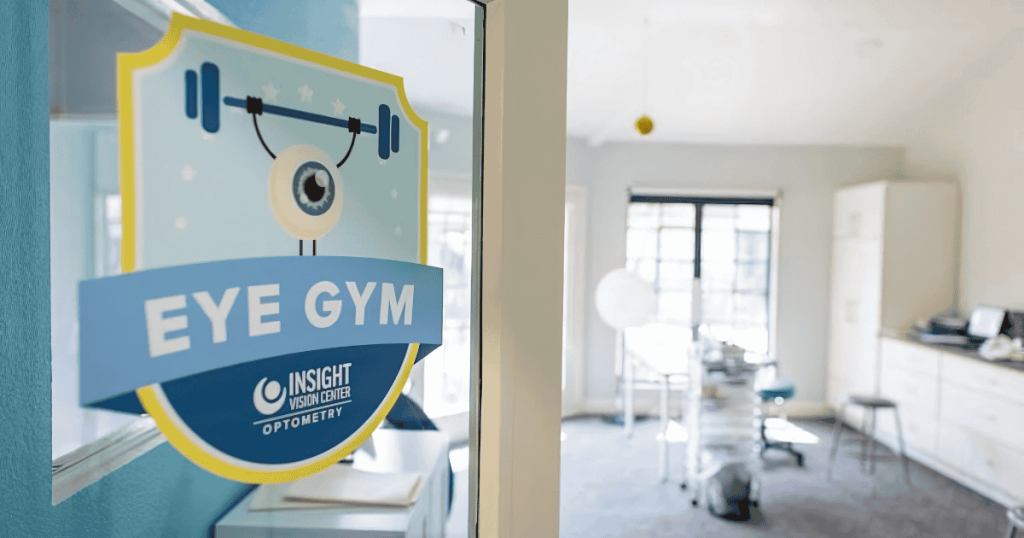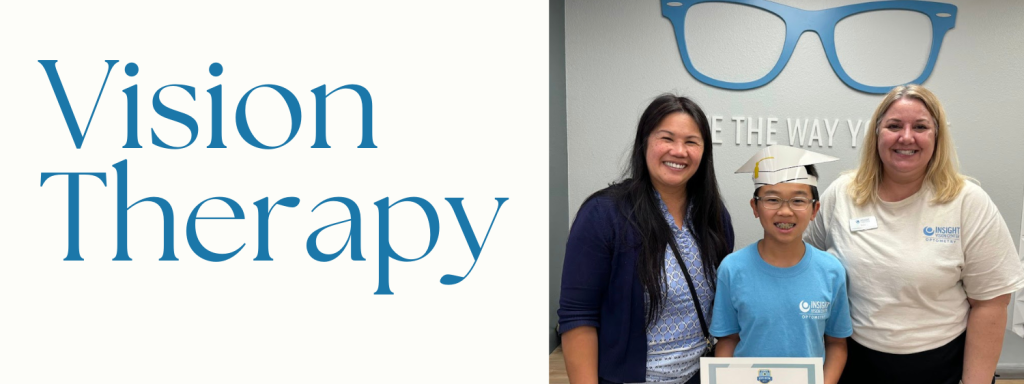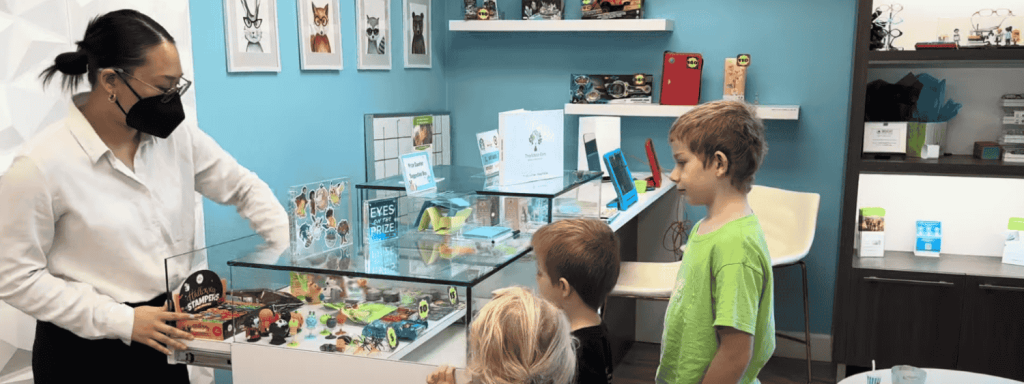If your child struggles with reading, learning, attention or physical symptoms, the root cause may be convergence insufficiency. Our developmental optometrists Dr. Valerie Lam, OD, FAAO, FOVDR and Dr. Ariel Chen, OD have extensive experience as pediatric eye doctors with a focus on identifying the hidden vision problem that are all too often missed by vision screenings and routine eye exams, to unlock your child’s potential.
Key Points:
- Convergence insufficiency affects 5-15% of children, impairing their ability to read, learn and succeed
- Symptoms include eye strain, blurred/double vision, headaches, difficulty reading and short attention span
- Kids are often misdiagnosed as ADHD or Dyslexic due to the similarity of symptoms
- Standard vision screenings and eye exams often miss convergence insufficiency
- Vision therapy is the research-backed treatment that helps the eyes team and focus properly
Why Convergence Insufficiency Matters for Your Child’s Success
School requires hours of reading and near work each day. But for children with convergence insufficiency (CI), this essential visual skill is a struggle. Their eyes have difficulty turning inward together to focus on close objects like books or tablets.
As a result, words may appear blurry or doubled. Children have to use excess effort to force their eyes to cooperate, leading to physical discomfort and trouble maintaining attention. Many kids with CI get frustrated, avoid reading, and fall behind in school. Their self-esteem and love of learning take a hit.
Parents and teachers often don’t realize a vision problem is at the root of the child’s challenges. They may mistake it for a lack of motivation, a learning disability, or ADHD. But in reality, the child’s visual system simply needs help developing the ability to converge the eyes and see clearly at near.
Prevalence: Up to 15% of children have convergence insufficiency
You are not alone if you suspect your child has an undiagnosed vision issue. Research indicates convergence insufficiency affects 5-15% of school-age children. That’s an average of 3-5 students in every classroom!
Yet unfortunately, 80% of children never receive a comprehensive developmental vision exam to detect CI and related visual disorders that impact learning. School screenings only check distance vision and are not designed to evaluate visual skills like eye coordination.
Even if your child had a basic eye exam and sees 20/20, they may still have convergence insufficiency. The standard eye chart test does not rule out CI. Only a complete binocular vision workup by a developmental optometrist can assess the eyes’ ability to focus and work together at near distances.
Without this, countless children go through school with an unidentified and untreated vision problem at the core of their academic troubles. But it doesn’t need to be this way for your child.
Understanding Convergence Insufficiency
To read and learn effectively, the eyes must focus and team as a synchronized pair. Convergence is the visual skill that allows the eyes to turn inward together to see a close target as a single, clear image. Each eye sees the object from a slightly different angle and the brain fuses the two images into one.
During early childhood, the visual system normally develops the capacity to converge the eyes and maintain this posture for extended near tasks like reading. But in some kids, the eyes remain more relaxed instead of converging fully, so each eye points slightly beyond the close-up focal point.
With convergence insufficiency, the eyes struggle to turn inward together the right amount and stay in that position. The visual system can’t process the two misaligned images, resulting in perceived blurriness, overlapping words, eyestrain, and loss of place when reading.
Impact on Your Child’s Life
When basic visual skills like convergence don’t develop properly, it can affect your child’s performance across all subjects and grades levels. CI makes reading and homework an unpleasant chore they want to avoid. Attention span shortens as their visual system fatigues.
In fact, a study of 221 5th and 6th graders found children with CI are 3 times more likely to be in the bottom 25% of their class compared to kids with normal binocular vision.
Your child may be very smart and capable, but get sidelined by the visual demands of schoolwork. They have to put in double or triple the effort of their peers to push through their blurry/doubled vision and physical symptoms. But eventually they hit a wall and can no longer compensate for their underdeveloped visual skills on their own.
CI can also interfere with your child’s physical and social development. Sports involving catching or hitting a ball become frustrating due to poor depth perception and eye-hand coordination. Some kids with CI get car sick easily or feel uneasy in visually busy environments. They may even be misdiagnosed with learning disabilities or ADHD due to their struggles with near work and concentration.
Your child’s quality of life and self-perception can take a big hit. But there is hope with vision therapy!
Recognizing Convergence Insufficiency Symptoms
If your child displays any combination of the following issues, consider scheduling a functional vision evaluation:
Vision-Related Symptoms:
- Eyestrain and fatigue with reading/near work
- Blurred/double vision
- Words appear to move or float on the page
- Difficulty shifting focus from near to far
- Print blurs or goes in and out of focus
- Squinting, closing or covering one eye
Learning Challenges:
- Avoids reading and near work
- Frequently loses place, skips lines
- Uses finger to keep place
- Comprehension declines with time on task
- Letter/word reversals
- Trouble concentrating on reading
- Difficulty completing homework
- Short attention span
- Labeled as “lazy” or “energetic”
Physical/Behavioral Signs:
- Headaches after reading
- Rubs eyes
- Blinks excessively
- Poor posture at desk – lies head down
- Fidgets and appears restless during reading
- Clumsy, poor sports performance
- Dislikes 3D movies
Many parents say in hindsight they knew something was “off” with their child’s vision and focus but couldn’t pinpoint why. That’s because convergence insufficiency doesn’t have obvious outward signs and standard vision screenings aren’t designed to test for it.
As a result, kids often struggle for years with unidentified CI before their visual skills are comprehensively assessed. But the earlier you can detect and treat convergence insufficiency, the sooner your child can get back on track with their learning and quality of life.
The Science Behind How Convergence Insufficiency Impairs Vision
With convergence insufficiency, the visual system cannot coordinate and sustain the inward pointing team alignment of the two eyes necessary to focus at close range. There are several key components involved:
Neurological Processes:
Convergence involves an intricate set of neurological messages between the brain and eye muscles. The midbrain controls the speed and precision of convergence/divergence movements. The pons area helps maintain close fusion.
Specific cells called “convergence neurons” activate to stimulate the eye muscles to turn the eyes inward together. With CI, there is an underdevelopment in this visual-motor pathway.
Eye Teaming/Alignment:
The inward rotation of each eye must be simultaneous and equal to fuse the object into a single 3D image. This keeps the target centered on the fovea (small central area of clearest vision) of each eye. But in CI, the eyes turn in sluggishly and tend to drift back outward, so the focal point doesn’t land on matching parts of each retina.
Accommodation:
To see clearly at various distances, the crystalline lens inside the eye must flex and change shape. This process, called accommodation, occurs in sync with convergence. For every 1 diopter of accommodative power, the eyes should converge about 4 prism diopters. Many people with CI have an imbalance in this ratio, where their focusing and convergence systems don’t work in harmony.
Eye Tracking:
The eyes make rapid jumping movements (saccades) about 4 times per second while reading to take in information. Each saccade should land on the same place in each eye to prevent double vision. But with CI, eye movement and placement aren’t precise. This visual confusion triggers strain as the brain tries to make sense of two unmatched images.
The ultimate problem in CI is the brain cannot merge the misaligned images from each eye into a unified, comfortable percept. Instead of the eyes effortlessly locking focus on the near target, the visual system struggles to force convergence against its own natural tendency.
It’s like flexing a weak muscle that continuously wants to yield to its original relaxed position. After 15-20 minutes of fighting this fatigue, the visual system gets overloaded. Blur, double vision, strain, and mental exhaustion set in.
Categories and Variations in Convergence Disorders
There are a few different ways convergence problems can manifest:
Low Fusional Ranges:
This is the most common type of convergence insufficiency. The eyes can momentarily join together at near, but have difficulty sustaining that posture. Fusion breaks too easily, causing intermittent double vision. Convergence amplitudes (strength of convergence relative to target distance) are often reduced, testing below 20-30 prism diopters.
Receded Near Point:
The near point of convergence (NPC) measures the closest distance the eyes can maintain fusion before one eye drifts outward. With CI, the NPC is often 8-10 cm or more away from the bridge of the nose (normal NPC is about 5 cm). A receded NPC indicates convergence fatigue during prolonged near work.
High Exophoria:
Exophoria is the tendency for the eyes to naturally rest in an outward position when not actively focusing. CI patients often have a significantly greater exophoria at near than far. For example, they may measure 2 prism diopters exophoric at distance, but 12 prism diopters exophoric at near. This makes it harder to overcome the eyes’ inclination to point behind the close-up plane.
Convergence Excess:
In some cases, the eyes can over-converge, causing the focal point to cross too close in front of the target. This induces strain similar to CI and is likewise treated with vision therapy.

The Importance of a Developmental Vision Exam
Annual school vision screenings and basic pediatric eye exams are important for ruling out nearsightedness, farsightedness and diseases. But they do not fully test how the eyes perform together at near distances.
Only an in-depth binocular vision evaluation assesses convergence ability and other key visual skills involved in reading and learning. Yet just 5% of children under age 6 receive this type of exam from an eye doctor. Many kids reach high school before their CI is diagnosed and treated.
In our practice, we routinely detect convergence and eye teaming problems missed by prior eye exams. These issues require testing beyond the basic eye chart, including:
Eye Movement and Teaming Tests:
- Convergence and divergence ranges
- Near point of convergence (NPC)
- Pursuits and saccades
- Stereovision (depth perception)
- Accommodative tests (focusing speed/accuracy)
Vision Processing Assessments:
- Laterality and directionality
- Visual form discrimination
- Visual memory
- Visual motor integration
In these ways, developmental optometrists test how comfortably and efficiently your child’s eyes work together as a team to read, learn and function. If we detect convergence problems, we custom design a vision therapy program to strengthen these skills and resolve symptoms.
Differentiating Convergence Insufficiency From Related Conditions
Testing for co occurring vision deficits
Sometimes convergence insufficiency occurs in combination with other vision deficits like refractive conditions, accommodative dysfunction (eye focusing problems). Amblyopia (“lazy eye”), strabismus (eye turn), visual processing deficits, or eye tracking issues may also be present.
It’s critical to test for these associated conditions because they can aggravate CI symptoms. For instance, if a child is farsighted (hyperopic), the visual system must work extra hard at near to compensate for the eyes’ natural tendency to over-focus behind the target. This can drain the convergence system’s resources.
Preventing misdiagnosis, ruling out vision problems for ADHD and dyslexic children
In other cases, convergence insufficiency may be misdiagnosed as a learning disability, ADHD or dyslexia because of the shared attention-deficit type symptoms or shared difficulty with reading. In fact, studies show up to 15% of children with CI meet the diagnostic criteria for ADHD.
For many children these labels may accurately describe aspects of their struggles, after all, if their vision makes it difficult to read or do school work, it is likely they will act out or have trouble focusing in class. But for many kids this does not address the underlying functional vision problem driving the learning and focusing challenges. Research indicates correcting CI with vision therapy can significantly reduce ADHD-like behaviors and enhance academic performance.
Even if your child does have a learning disability, dyslexia, or ADHD, treating their convergence insufficiency is still essential. By improving their ability to see without strain they will be better equipped for the challenges that they will face in the classroom or in other therapies, allowing other interventions to be effective. When visual skills are ignored, it deprives them of the opportunity to reach their full potential.
How Convergence Insufficiency Is Diagnosed
Diagnosing convergence insufficiency involves specific clinical measurements and observations, including:
- Exophoria:The eyes rest in an outward position when relaxed. CI patients have a significantly greater exophoria at near (e.g. >10 prism diopters) compared to distance.
- Receded Near Point of Convergence (NPC):The eyes struggle to sustain convergence and fatigue easily. Break point where fusion is lost is often greater than 6 cm from the nose.
- Reduced Fusional Ranges:Ability to converge the eyes and maintain binocular fusion measured in prism diopters. With CI, fusional convergence at near is often less than 15-20 prism diopters.
- Failure of Sheard’s Criterion:The fusional reserve (convergence amplitude) should be at least twice the near phoria to avoid strain. Many CI patients don’t have enough convergence power to meet this criterion.
- High CISS Score:The Convergence Insufficiency Symptom Survey is a standardized 15-question assessment of visual discomfort. A total score ≥21 indicates symptomatic CI.
- Poor Convergence Facility: Speed and ease of shifting convergence measured with near targets and prisms. With CI, the facility is often slower than 15 cycles per minute.
- Low Accommodative Convergence/Accommodation (AC/A) Ratio: The amount of convergence induced by focusing effort is less than normal (<4Δ/1D).
- Eye Movement Recording: Advanced eye tracking equipment shows convergence and divergence speeds, latencies and accuracies. CI patients often have slowed dynamics.

Vision Therapy Treatment for Convergence Insufficiency
Once our developmental eye doctors have confirmed that your child has convergence insufficiency, we develop a personalized vision therapy regimen to remedy it. Treatment typically involves a combination of weekly in-office therapy sessions and daily at-home exercises.
Research shows office-based vision therapy with home reinforcement is the most effective approach to build convergence skills and reduce symptoms. A major clinical trial from the National Eye Institute found 75% of kids with CI became symptom-free after completing in-office therapy with home practice.
In contrast, only 43% of children prescribed just 15 minutes of home pencil pushups improved, which was no better than placebo. Likewise, unsupervised computer programs had limited benefit.
These findings underscore that one-on-one office therapy under the direction of a developmental optometrist and with a trained vision therapist makes all the difference. At our practice, we use the latest technology, equipment and expertise to deliver results for your child.
Examples of vision therapy activities for convergence insufficiency
In-Office Vision Therapy Procedures:
- Brock String
- Vectograms
- Aperture Rule
- Eccentric Circles
- Life Saver Cards
- Lens Sorting
- Prism Jumps
- Computerized Therapy
Home Therapy Reinforcement:
- Convergence Pencils
- Hart Chart Saccades
- Loose Lens Accommodative Facility
- Fusion Cards
- Barrel Card Fusion Ranges
- Bingo Bed Vergence Ranges
- Life Saver Card Jumps
- Alphabeticized Pegboard
Our pediatric eye doctors and therapists precisely monitor your child’s progress and adjust the program as their visual skills improve. The goal is to develop convergence and fusion (joining of the two eyes) into an automatic, integrated process.
With commitment and practice, your child can achieve clear, comfortable binocular vision when reading and concentrating up close. It’s so rewarding to see their confidence and abilities soar as they conquer this visual obstacle!
The Science and Research Behind Vision Therapy
Extensive research confirms vision therapy builds sustainable convergence skills and eliminates symptoms. The Convergence Insufficiency Treatment Trial (CITT) — a rigorous multi-center NIH study — produced these compelling results:
After 12 weeks of vision therapy:
- Near point of convergence improved 4x more than pencil push-ups and 3x more than placebo
- Positive fusional vergence increased 13Δ in vision therapy group vs 6.8Δ with pencil push-ups vs 5.8Δ with placebo
- CISS symptom score reduced from 29 to 9 in vision therapy group (normal)
- 73% of patients had full resolution of symptoms with vision therapy vs 47% with pencil pushups vs 35% with placebo
1 year post treatment:
- 88% of children who received vision therapy maintained their symptom relief and convergence improvements
- Pencil pushup group symptoms regressed close to baseline
Numerous other studies validate vision therapy’s efficacy for CI:
- A Meta-analysis of 10 studies found strong evidence for clinic-based vision therapy in kids and adults, but not for home-based treatment alone
- fMRI showed vision therapy altered neurological activity in the brain areas responsible for convergence control
Our doctors closely follow these evidence-based protocols when treating your child. We’re proud to offer the highest standard of care proven to get your child back on the road to visual success.

What to Expect from Vision Therapy
A typical vision therapy program for convergence insufficiency spans roughly 25 weekly sessions. The exact duration depends on symptom severity and compliance with home exercises. During each office session, your child works one-on-one with an experienced vision therapist for 45 minutes.
The therapist leads them through sequenced activities designed to:
- Enhance convergence strength and sustainability
- Equalize the two eyes’ convergence effort
- Improve convergence/divergence speed and accuracy
- Coordinate convergence with focusing (accommodation)
- Integrate convergence with eye tracking and visual processing
We structure the therapy as a success-building process. In the beginning, your child practices converging under simplified conditions with strong feedback cues. As these basic skills become easy, we gradually add real-world challenges like complex backgrounds.
Your child can see their gains with each exercise and takes pride in reaching new levels. We make it engaging with fun gadgets, computer games, and prizes. But it’s not just play – each activity has a purpose and the results show!
In addition to the weekly sessions, daily activities are done at home in between therapy sessions.
Many parents report their child’s symptoms start reducing within 6-8 weeks. Reading becomes easier, comprehension improves, and school grades often rebound. Personality wise, patients seem happier, more energetic and willing to socialize.
By the end of the program, we retest all diagnostic measures. We have incredible success with virtually all of our CI patients getting them to achieve full symptom resolution and at least double their original convergence abilities. Their visual skills are brought up to developmental norms for their age. Insight Vision Center Optometry is a top-rated pediatric vision center, serving children from across Orange County, including Irvine, Huntington Beach, and Santa Ana.
Case Reports: Patient Successes
Sarah, Irvine, CA
7 years old, 2nd grade. Referred by occupational therapist for reading problems.
Symptoms: skips lines, loses place, says eyes are tired, takes 2 hours to do 20 minutes of homework
Diagnosis: NPC 13cm, near exophoria 15Δ, fails Sheard’s criterion, fusion ranges 8/12/4
Treatment: 24 sessions of vision therapy over 6 months, 98% compliant with home therapy
Results: NPC 3cm, near exophoria 6Δ, passes Sheard’s, fusion ranges 25/35/25, symptoms resolved, reading at grade level
Dave, Orange, CA
22 years old, college student. Self-referred for headaches and blurred vision with studying.
Symptoms: eye strain, words blur after 20 minutes of reading, frequent study breaks, headaches 3-4x/week
Diagnosis: NPC 11cm, near exophoria 17Δ, reduced vergence facility of 3 cycles per minute
Treatment: 24 sessions of vision therapy over 4 months plus home computer orthoptics program
Results: NPC 5cm, near exophoria 4Δ, vergence facility 15 cycles per minute, reads 2+ hours without symptoms, no headaches in 2 months
Tips and Strategies for Parents
- Trust your instincts. If your child is struggling more than peers with reading or attention, don’t wait to get their vision checked. You know your child best. Insist on a comprehensive binocular vision exam, not just a basic eye test. Look for a developmental optometrist with the experience for diagnosing and treating CI.
- Act early. Convergence insufficiency is easier to correct at younger ages when the visual system is highly adaptable. But it’s never too late to rewire the brain and eyes to work better together.
- Make vision therapy a priority. Consistent attendance at office sessions and adherence to home exercises is key. Offer praise and rewards for your child’s progress.
- Advocate for your child. Share their diagnosis with teachers so they can receive accommodations like extra test time. CI qualifies as a Specific Learning Disability under IDEA law.
- Be patient. It takes time to build new visual habits and neurological pathways. Most kids show functional improvements in 8-12 weeks but need the full 6 month program for lasting results.
- Celebrate the small victories. Let your child know how proud you are when they finish a book or ace a spelling test. They’ve overcome a major hurdle!
Advice for Educators and Professionals
Children with convergence insufficiency need our support in the classroom and community. As many as 1 in 4 students have an undiagnosed binocular vision deficit at the root of their challenges.
You can play a vital role in spotting kids who show signs of visual strain and referring them for a developmental vision exam.
Common symptoms include:
- Low reading comprehension compared to oral vocabulary
- Poor ability to copy notes from board
- Extreme frustration with timed tests
- Short attention span (<15 minutes) with near work
- Bypasses reading whenever possible
- Poor sports performance with catching, hitting, judging distances
- Clumsiness, often bumps into things
- Behavioral outbursts when doing visual tasks
- Labeled “lazy”, “distracted”, or “slow processor”
The good news is vision therapy offers a solution. Studies show it can improve reading speed, concentration, and sports proficiency by developing the child’s eye coordination skills.
If a student has been diagnosed with convergence insufficiency, these accommodations can help:
- Extra time (50-100%) on tests
- Reduced homework load
- Simplified worksheets (less visual clutter)
- Large print books
- Raised reading stand to reduce forward head tilt
- Frequent rest breaks from close work
- Recorded or audible books
- Typing instead of handwriting
- Oral exams
We encourage all educators and pediatric healthcare professionals working with kids to add functional vision to their checklist when learning problems arise. Together, we can ensure every child gets the visual assessment and treatment they need to succeed.

Orange County’s Trusted Pediatric Eye Care Team
At Insight Vision Center Optometry, Dr. Valerie Lam, OD, FAAO, FOVDR and Dr. Ariel Chen, OD lead our pediatric eye care services, offering Orange County families a range of advanced options for their children’s vision health. From developmental eye exams and myopia control to vision therapy and post-concussion care, our doctors bring unmatched expertise and a warm, kid-friendly approach. Referrals from across Orange County reflect our commitment to providing knowledgeable care with the latest in technology.
If you suspect your child has convergence insufficiency, don’t hesitate to schedule a developmental vision evaluation with our office. If convergence insufficiency or a related issue is detected, we’ll design a customized vision therapy program to give your child the visual skills they need in school and beyond.
Let’s work together to help your child break free from convergence insufficiency and open their world to visual success!





